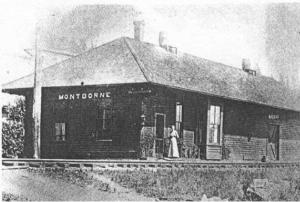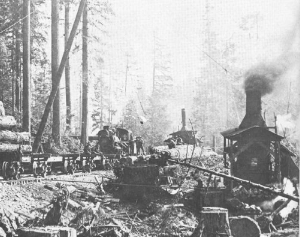Railroads at Fire Mountain
1900s - 1922

Railroads and logging are inextricably linked in the history of Fire Mountain and Skagit County. Without the existence of railroads connecting the area to the major economic hubs of Everett, Seattle, and Vancouver, large-scale logging could not have taken place. In turn, eff orts to extend logging deeper into the mountains necessitated the building of railroad grades for transporting timber, men, and equipment. These logging railroads extended from Montborne on Big Lake through the current location of Fire Mountain and up the slopes of Cultus Mountain, and relics of this period of camp history are evident throughout camp.
The first railroad in the area was the Seattle, Lakeshore, and Eastern Railroad, completed in 1891,which ran from Sedro (now Sedro-Wooley) south past Clear Lake, Big Lake, and Lake McMurray continuing to Seattle completed in 1891. This railroad, served by both passenger and container trains, spawned numerous settlements that became local centers of the timber industry: Clear Lake, Big Lake, Montborne, Ehrlich, and McMurray. During the 1890s this lucrative railroad route was taken over first by the Northern Pacific Railroad and then by the Great Northern Railroad.
The first logging railroads in the vicinity of Fire Mountain were laid by the Day Lumber Company, which was based at Big Lake, in the early 1900s. By 1911 these railroads extended east of Big Rock and through the flatlands near Big Lake, and in 1913 the Day Lumber Company acquired a new Shay locomotive for logging over the steep grades in the foothills of Cultus Mountain. The Shay was a three-car locomotive with the road number “3.”

Looking at a map of Day Lumber Company railroads in 1917, it is evident that the company was actively involved in logging on the current premises of Fire Mountain. Part of Day’s railroad east of Big Lake crosses Walker Creek and loops southward around the present site of Lake Challenge before switchbacking across the Nookachamps and up the slopes of Cultus Mountain. 1916-1917 is a pivotal year in that at this time Day’s logging activities were centered in Walker Valley, as well as because crews building the railroads discovered coal veins that later became the Blumont Coal mine, located on the Tracy property adjacent to Fire Mountain. A map identifying Day railroads in 1922 seems to indicate that these grades were no longer in use by 1922, indicating that logging in the area was possibly exhausted by this time. Sections of this railroad are now the main road around Fire Mountain and the road leading up Cultus Mountain.
1922 - 1935

By 1921 The Day Lumber Company had 12 miles of railroad and two geared locomotives in use, along with eight donkey engines. In 1924, Day was up to 20 miles of railroad and 50 logging cars. However, the financial health of Day was shaky and it went into receivership in 1925 after a fire at the sawmill at Big Lake, going out of business in 1926.
The Nelson-Neal Lumber Company, based in Montborne, was also active in the Fire Mountain vicinity. In 1918 Nelson-Neal built a railroad from Montborne into Walker Valley now followed by Walker Valley Road. This railroad crossed the Day route approximately on current Fire Mountain property. In 1924 Nelson-Neal had 5 miles of railroad, 8 skeleton cars, two flat cars, and 5 donkey engines. In 1926 Nelson-Neal folded and sold its assets to the Montborne Lumber Company, which continued logging up the slopes of Cultus with 2 Shay engines, 4 donkey engines, and 8 miles of railway. Montborne collapsed in 1930 after one of the engines was wrecked and a forest fire burned out the railroad. After 1935 a truck road was built from Montborne to Cultus Mountain, after which the railroads were abandoned.
There are several areas in and around camp where the legacy of the railroads are evident. The road from Enumclaw campsite all the way to Howling Coyote follows the Day Lumber Company railroad grade. Just where the road past Enumclaw campsite bends left in the direction of the OA site, a wide, level path heads to the right in the direction of the large fields. This is a section of an old railroad grade not turned into a truck road later on. Another section of this railroad grade is evident at the far northern end of this road, just past the Howling Coyote outpost site. Just below the mining shaft on the Cultus trail before it meets the DNR road is another old, overgrown section of railroad grade. Yet another branch of railroad grade extends northwest from the camp ranger’s house. The Settler’s Trail east of camp (the trail to Cultus Mountain and Split Rock) features the remains of one railroad bridge over a creek. Other sections of railroad grade extend through the Cultus foothills east of camp, although recent clear-cut logging on DNR land has obscured some of these routes. Campers have on occasion found old railroad spikes on hikes through this area. And Donkey Vista, near the summit of Cultus, is so named because of the abandoned steam donkey left there.